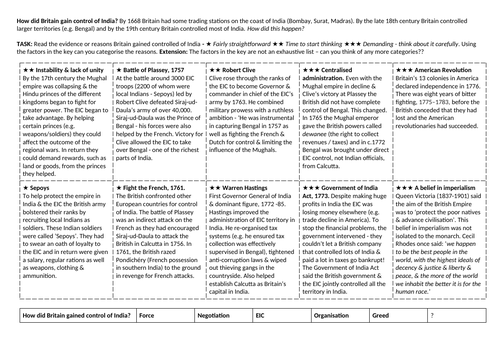


Part 2 of a very straightforward presentation on how Britain gained controlled of India. However, the second part offers more analysis of the methods used by the British to gain & consolidate control over India.
The aim of the presentation was to build on the ideas covered in part 1 whilst the worksheet was created so that all my GCSE students could explain in some detail how & why the British expanded their empire in India.
The worksheet covers a range of factors (Sepoys, Robert Clive, fighting the French, a belief in imperialism, instability within the Mughal empire & a lack of unity between different Hindu princes…) and very simply differentiates the evidence (one-star for ‘straightforward’ through to three-stars for ‘think about it carefully’) so that all students can quickly see the challenge offered by each idea and choose their starting point accordingly. A key gives the worksheet a simple focus - categorise the reasons Britain gained controlled under themes such as force, negotiation & greed. There is also space for students to think of their own categories.
Lastly, the presentation tries to take students beyond the core textbooks by bringing in a couple of thoughts from Sashi Tharoor’s brilliant book ‘Inglorious Empire’.
Suitable for many GCSE History specs:
AQA GCSE History: Britain: Migration, empires and the people: c790 to the present day (an option in Section A of Paper 2 - Thematic studies).
Edexcel GCSE History. Probably not essential but offers perspective to issues within the ‘British America, 1713–83: empire and revolution’ unit (a period study option in Paper 2) and would help more able students understand what the British were up to in India as a comparison to the colonisation of north America.
OCR GCSE History A. Links to the section on the growing trade with India and China and role of the East India Company within the Paper 3 British depth study - Impact of Empire on Britain 1688–c.1730.
OCR GCSE History B - Schools History Project. Links to the Early Modern Britain c.1500–c.1750 section within the Paper 1 thematic study - Migrants to Britain, c.1250 to present; difficult to do an overview of ‘the growth in world trade’ without mentioning India & EIC.
Something went wrong, please try again later.
This resource hasn't been reviewed yet
To ensure quality for our reviews, only customers who have purchased this resource can review it
Report this resourceto let us know if it violates our terms and conditions.
Our customer service team will review your report and will be in touch.